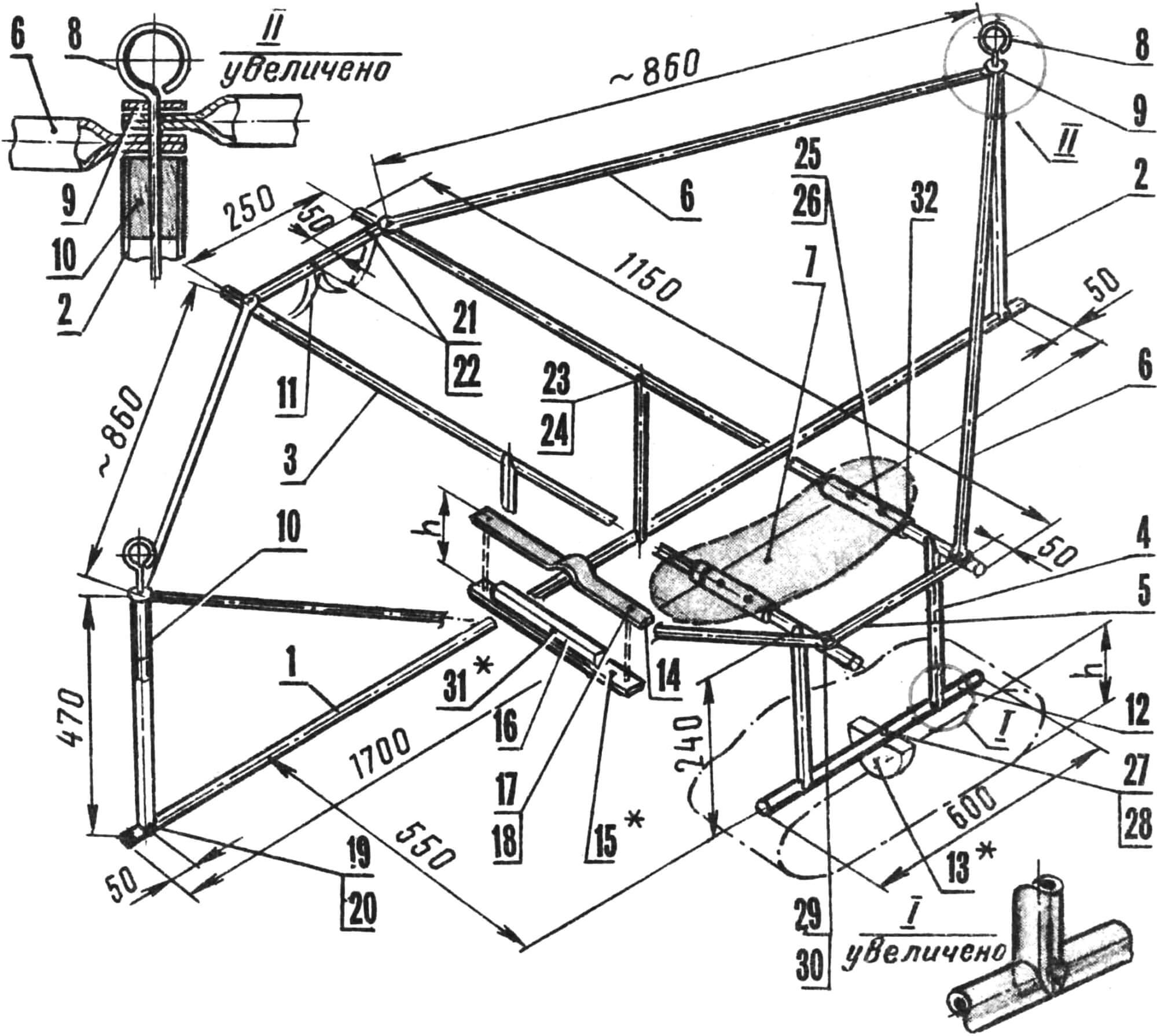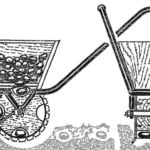The sailboard has gained enormous popularity today. More and more bodies of water “bloom” with its bright triangles in the summer. However, when there is no wind, windsurfers and their sails lie along the shores mostly idle. And then athletes should remember another wonderful type of water sport – rowing.
Let us remind you that rowing’s health benefits are not inferior to such sports as walking, running, skiing, swimming, cycling, and aerobics. It even further strengthens the muscular, cardiovascular and respiratory systems of the body. This is also excellent gymnastics for the joints. Consistent tensile load on the wrist, elbow and shoulder joints; a smooth, increasing load on all parts of the spinal column is especially useful for windsurfers.
Therefore, we offer you a description and drawings of a device that can turn any windsurfing board into a sports rowing vessel, assembled from the body of a sailing board, collapsible oars and a rowing device.

1 — sailboard body, 2 — dismountable oars (2 pcs.), 3 — assembled rowing device.
The rowing device weighs about 8 kg. It is attached to the body of the board through the centerboard and steps wells; consists of a sliding seat, rests for the rower’s feet, racks with oarlocks secured with braces and a fastening system to the body of the board.
No modifications to the windsurfer’s hull are required when converting it into a rowing version. Installation and detachment is done very quickly, within 5-7 minutes.
The rowing device is assembled on two duralumin pipes: long and short, which serve as the basis for fastening the racks and longitudinal links (seat guides). Oarlock stands are attached to the long base pipe at the ends. The latter are inserted into the holes of wooden inserts-bosses. The forces from the oars are transmitted through the rowlocks and guy wires to the ends of the longitudinal links. The oarlocks themselves rest on the bosses through steel washers.
The bushings are attached to the plastic or fiberglass seat with screws and nuts – on them the seat slides along longitudinal links, which, in turn, are fastened with cross members (aluminium tubes with flattened ends).
The racks in the lower and upper parts have cutouts according to the diameter of the pipes. They are connected to these pipes with bolts. A well-fitted connection of this type is very reliable.
To secure the rower’s toes, leg straps are attached to the rear crossbar with bolts and nuts. The rower’s heels rest on the deck of the sailboard hull.

1 – large load-bearing cross member of the base (pipe D16T, Ø 32X2 mm), 2 – oarlock stand (pipe D16T, Ø 40X1 mm, 2 pcs.), 3 – longitudinal connection-guide seat (pipe D16T, Ø 25X1 mm, 2 pcs.), 4 – stand (pipe D16T, Ø 40Х1 mm, 4 pcs.), 5 — upper cross member (pipe D16T, Ø 25X1 mm, 2 pcs.), 6 — spacers (pipe D16Т, Ø 16Х1 mm, 4 pcs.), 7 — seat (fiberglass), 8 — oarlock (pipe, stainless steel Ø 10Х1 mm, 2 pcs.), 9 — washer (Ø 20X10 mm, thickness 2 mm, stainless steel, 2 pcs.), 10 — insert (oak, beech, 2 pcs.), 11 — leg strap (nylon, 2 pcs.), 12 — small load-bearing cross member of the base (D16T, pipe Ø 32X2 mm), 13 — mast steps insert (D16T), 14 — upper mounting bar for the rowing device to the centerboard well (D16T, thickness 3 mm), 15 — lower fastening bar (D16T, thickness 3 mm), 16 — retainer (oak, beech), 17 — M6X180 pin (stainless steel, 2 pcs.), 18 — M6 nut (4 pcs.), 19 — M6X45 bolt (2 pcs.), 20 – M6 nut (2 pcs.), 21 – M6X30 bolt (3 pcs.), 22 – M6 nut (3 pcs.), 23 – M6X45 bolt (8 pcs.), 24 – M6 nut (8 pcs.), 25 – M6X20 screw (4 pcs.), 26 – M6 nut (4 pcs.), 27 – M8X40 stud, 28 – M8 nut, 29 – M6X45 bolt (4 pcs.), 30 – M6 nut (4 pcs.), 31 – 5X30 screw (2 pcs.), 32 – sleeve (D16T pipe, Ø 30X1 mm, 2 pcs.). Parts marked with an asterisk are manufactured in accordance with the design of the centerboard and step wells of the sailboard; h is the thickness of the sail board.
The rowing device is attached to the hull of the sailboard through the centerboard well using a metal strip that has a bend in the middle part along the diameter of the base pipe. It, in turn, is attracted by studs and nuts through the bar to the deck and bottom. A wooden insert is secured to the plank with screws, securing the entire structure.
Additional fastening of the rowing device is carried out through the step well of the board body to the step liner of the mast with a pin and nut through a small base pipe. Depending on the design of the mast attachment to the board body, this unit may be different.
To make an oar, you will need a duralumin pipe Ø 36X1.5 mm with a length of 1700 mm, a wooden handle insert and a blade from a kayak oar.
By making this simple rowing device, you will get great pleasure from rowing on the mirror-like surface of a reservoir in calm weather. The board, under powerful strokes, quickly slides along the surface of the water. And you can ride small children on the board as passengers. They are delighted with these walks. Just don’t forget to wear life jackets!
N. SHERSHAKOV



